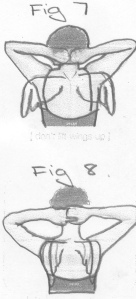In order to begin The Pilates Method of conditioning. It is important to master the basic fundamentals of each exercise. This is true for anyone no matter how fit ( or unfit) they may be.
Move through the levels at a pace that works feels comfortable for you, experienced Pilates students can work through the fundamentals in any order. However if you have never done Pilates before please start at the beginning. Take time to learn the movements properly and don’t rush your progress.
Before you begin make sure you have a Mat. The foam should be dense enough to protect the vertebrae in your spine. Some of the exercises involve rolling on your back.
I would recommend wearing comfortable clothing that you can move freely in.You might want to wear fitted clothing that will help you to see the muscles of your body as they work, but it is more important to feel comfortable. Do not wear shoes.
Make sure you have enough space to move around in , you should be able to move your arms and legs around freely in all directions as well as be able to stretch to the full length of your body. Pack away any sharp or delicate objects that may get in the way.
When you begin your workout, make sure you are well rested otherwise the movements may prove to be too strenuous for you . Do not exercise if you are on any medications that make you drowsy or hyperactive, this will affect your concentration and concentration is key when performing exercises of The Pilates Method.
Here are some of the basic Fundamentals to remember :
“Pooching” or Scooping:
*Do scoop by pretending your belly button is “anchored” to your spine.
*Scooping also helps to provide a longer waist makes your abdominals contract, this provides more support to your lower back.( Fig 2)
Perfect Posture:
To maintain the perfect posture :
*Dont sway and arch your back
*Tuck your pelvis under without slouching. ( Fig 3)
*Lift your chest , scoop your belly deep into your spine and lengthen through the crown and tailbone. Imagine there is a long iron rod running down your spine from head to toe. Keep your shoulders pulled down. ( Fig 4)
Breathing:
Breathing in Pilates is inhaling through your nose and exhaling through your mouth ( as if blowing out through a straw)
*Inhaling: Expand your chest and lungs. (Fig 5)
*Exhaling : expel the air from your lungs as if you were squeezing the air from an accordion. ( Fig 6)
*Remember to inhale and exhale using the entirety of your lungs , not your belly!
The position of our necks and shoulders is very important for maintaining correct posture.
*Imagine your shoulder blades have wings attached; don’t pull your wings up. ( Fig 7)
*Do keep shoulders actively pressed down and away from your ears, use your muscles to pull shoulder blades down into the center of your back. Do pull your “wings” down. ( Fig 8 )
These movements will eventually become a habit and you will be able to incorporate them into your daily life and practice them unconditionally.





